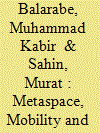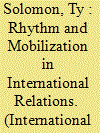| Srl | Item |
| 1 |
ID:
175108


|
|
|
|
|
| Summary/Abstract |
The street vendor’s (SV) potential mobility in subverting authorities’ hegemony over public space has been theorised within the contexts of urban informality and resistance. Discussions mainly revolve around movement tactics as resistance strategy while evading arrests and confiscations. This negates SV agency and limits understanding mobility in resistance. Using Bunschoten’s metaspace and Cresswell’s aspects of mobility, this paper employs semi-structured interviews with mobile SV, road users and pedestrians in Kano (Nigeria), to describe vendors’ mobile practices and how they delay hostility from the state. Observing the interplay between vendors, users and environment, this paper identifies four types of vendor movement: focused, targeted, sporadic and self-regulatory; and examines how vendors exploit Cresswell’s speed and rhythm in challenging formal urban practice hegemony through continuous operation. The paper also describes how vendors’ movement affects other actors’ mobilities. Finally, the paper discusses urban design implications for integrating SV within city plans, setting out potential proposals.
|
|
|
|
|
|
|
|
|
|
|
|
|
|
|
|
| 2 |
ID:
170020


|
|
|
|
|
| Summary/Abstract |
International Relations (IR) has rarely considered rhythm as a topic of analytical attention. Yet rhythms permeate many social and political phenomena, and their study contributes to core debates and empirical insights in contemporary IR. Rhythms are similar to but distinct from other forms of repetitive, iterative social action that have garnered increasing interest in IR, such as practices, habits, and routines. Each of these phenomena has rhythmic elements, but not all rhythmic phenomena are practical, habitual, or routine. Rhythm, then, is a distinct category of iterative action that is effectively positioned to unpack a wider array of practices in a broader range of cases. Moreover, contrary to common conceptions as simple repetition, the multiplicity and dynamism of social rhythms hold the potential to produce novel political formations. This article outlines a framework for the study of rhythms in IR by delineating some key features of social rhythms and three kinds of sociopolitical effects that they have in collective contexts. These theoretical developments are empirically applied to understand neglected aspects of mass mobilization during the Arab uprisings of 2011.
|
|
|
|
|
|
|
|
|
|
|
|
|
|
|
|